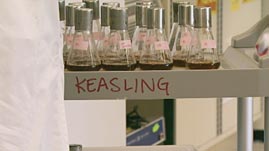Teachers' Domain - Digital Media for the Classroom and Professional Development
User: Preview


Source: KQED Quest: "Biofuels: Beyond Ethanol"
This video segment adapted from KQED's QUEST profiles the work of Jay Keasling, a synthetic biologist experimenting with ways to produce a cleaner-burning fuel from biological matter, using genetically modified microorganisms. Keasling's approach involves engineering microbes to eat simple sugars found in plant matter and then excrete fuel. The video explains the two techniques that may enable Keasling to accomplish this: metabolic engineering and directed evolution. It also suggests that creating biofuels from plants may actually contribute to global warming rather than help combat it.
Ethanol, a biofuel derived from corn kernels, is not an ideal fuel for the long term. Its energy density—the amount of energy stored per unit volume—is about two-thirds that of gasoline. Because it is highly corrosive, it cannot be used in conventional automobiles unless the fuel system is modified. Nor can it be stored and transported in the tanks and pipelines currently used for petroleum-based fuels. Lastly, because it comes from a major food crop, using it to produce biofuel drives up its cost, creating a "food or fuel" conundrum and raising serious concerns about food shortage.
Synthetic engineers are part genetic engineer, part molecular biologist, part chemist. By using genetic and biological tools and techniques, Jay Keasling is working to get a fuel-grade alcohol like ethanol out of plant matter. But Keasling's biofuel would not have the same drawbacks as corn-based ethanol. The key to Keasling's work is engineering microorganisms to convert simple sugars found in plant matter into fuel—without using up lots of energy in the process. Because microbes don't do this naturally, they need to be changed via two methods: metabolic engineering and directed evolution.
Metabolic engineering aims to redesign an organism's metabolic network and regulatory functions so that it produces a specific outcome. Each reaction in a cell is catalyzed by an enzyme. That enzyme's concentration can be increased or decreased by changing either the number of copies of the gene responsible for producing the enzyme, or the rate at which the gene is activated and commands the cell to produce the enzyme. To eliminate an undesired outcome, the gene responsible for producing the enzyme can be deleted, in a process called gene knockout.
As Keasling states in the video, metabolic engineering will get you 90 percent of the way toward the outcome. The remaining 10 percent can be achieved by directed evolution. While evolution by natural selection occurs in nature, directed evolution occurs in the controlled conditions of a lab. It involves first setting those conditions so that random mutations occur as an organism reproduces. Next, the synthetic engineers screen the offspring that result. They select those offspring with genes that make them better suited to do a specific job. So, while evolution by natural selection is not always directed toward a goal that is beneficial to humans, directed evolution can be channeled to produce a specific desired outcome.
Keasling hopes to evolve microorganisms with genes that help them efficiently transform plant matter into fuel. He starts with organisms that are already good at breaking down plant matter, and tries to genetically engineer them so that they can do that more efficiently. Keasling's challenge is made more difficult by the fact that biofuels are typically toxic to a cell. Since producing toxic products goes against homeostasis—the balance between internal and external environment that cells must maintain in order to survive—Keasling must also find a way to deactivate or bypass certain cellular mechanisms that would otherwise prevent the organism from producing the fuel.
 Loading Standards
Loading Standards Teachers' Domain is proud to be a Pathways portal to the National Science Digital Library.
Teachers' Domain is proud to be a Pathways portal to the National Science Digital Library.
